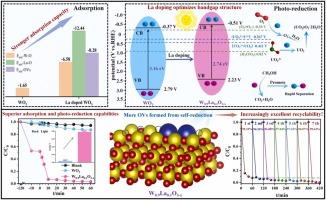通过la掺杂WO3促进电子空穴分离和增强铀(VI)捕获:对氧空位和卓越可回收性的见解
IF 11.3
1区 环境科学与生态学
Q1 ENGINEERING, ENVIRONMENTAL
引用次数: 0
摘要
wo3基材料由于其稳定性和低带隙(~2.8 eV),理论上是脱除铀(VI)的有前途的光催化剂,但由于缺乏吸附位点和光生电子-空穴对重组的趋势,它们受到限制。本文采用简单的水热法制备了富氧空位(OVs)的la掺杂WO3 (W0.9La0.1O3-x)。La掺杂和OVs的引入为w0.9 la0.1 - o3 -x提供了丰富的活性位点,优化了能带结构,提高了电子密度,抑制了电子-空穴对的重组,通过协同吸附-光催化还原过程,最大U(VI)萃取量可达1199.73 mg/g。有趣的是,w0.9 la0.1 - 10 -x表现出优异的稳定性和更高的可回收性,优于大多数报道的吸附剂和光催化剂,这可能是由于W和La原子的强稳定性以及w0.9 la0.1 - 10 -x在光催化反应过程中自还原形成的额外OVs。总体而言,本研究拓展了wo3基材料在废水中脱除U(VI)的应用,为解决U(VI)萃取材料去除率与稳定性平衡的难题提供了有价值的理论见解和技术指导。本文章由计算机程序翻译,如有差异,请以英文原文为准。

Facilitated electron-hole separation and enhanced uranium(VI) capture via La-doped WO3: Insights into oxygen vacancies and superior recyclability
WO3-based materials are theoretically promising photocatalysts for uranium(VI) removal due to their stability and narrow bandgap (∼2.8 eV), but they are limited by a lack of adsorption sites and a tendency for photogenerated electron-hole pairs to recombine. Herein, La-doped WO3 (W0.9La0.1O3-x) rich in oxygen vacancies (OVs) was prepared via a facile hydrothermal method. La doping and the introduction of OVs provided abundant active sites, optimized the band structure, increased electron density, and inhibited electron-hole pair recombination of W0.9La0.1O3-x, which resulted in a maximum U(VI) extraction capacity of up to 1199.73 mg/g through synergistic adsorption-photocatalytic reduction processes. Interestingly, W0.9La0.1O3-x demonstrated excellent stability and increased recyclability, superior to that of most reported adsorbents and photocatalysts, probably owing to the strong stability of W and La atoms as well as the additional OVs formed from self-reduction of W0.9La0.1O3-x during photocatalytic reaction process. Overall, this study expands the application of WO3-based materials for U(VI) removal from wastewater and provides valuable theoretical insights and technical guidance for addressing the challenge of balancing removal rate and stability of U(VI) extraction materials.
求助全文
通过发布文献求助,成功后即可免费获取论文全文。
去求助
来源期刊

Journal of Hazardous Materials
工程技术-工程:环境
CiteScore
25.40
自引率
5.90%
发文量
3059
审稿时长
58 days
期刊介绍:
The Journal of Hazardous Materials serves as a global platform for promoting cutting-edge research in the field of Environmental Science and Engineering. Our publication features a wide range of articles, including full-length research papers, review articles, and perspectives, with the aim of enhancing our understanding of the dangers and risks associated with various materials concerning public health and the environment. It is important to note that the term "environmental contaminants" refers specifically to substances that pose hazardous effects through contamination, while excluding those that do not have such impacts on the environment or human health. Moreover, we emphasize the distinction between wastes and hazardous materials in order to provide further clarity on the scope of the journal. We have a keen interest in exploring specific compounds and microbial agents that have adverse effects on the environment.
 求助内容:
求助内容: 应助结果提醒方式:
应助结果提醒方式:


